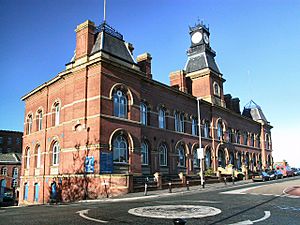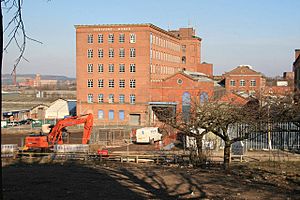Platt Brothers facts for kids
| Founded | 1770 |
|---|---|
| Defunct | 1982 |
| Headquarters | Werneth, Oldham, England |
|
Key people
|
Henry Platt |
| Products | Textile-processing machinery |
|
Number of employees
|
15,000 |
Platt Brothers, also known as Platt Bros & Co Ltd, was a very important British company. It was based in Werneth, a part of Oldham, North West England. This company made machines for making clothes and fabrics, called textile machinery. They also worked with iron and owned coal mines. By the late 1800s, Platt Brothers became the biggest textile machinery maker in the world! They had more than 12,000 people working for them.
Contents
The Company's Journey
The story of Platt Brothers began in 1770 with Henry Platt. He was a blacksmith who made parts for machines that prepared cotton. His grandson, also named Henry, started a similar business.
In 1820, this grandson, Henry Platt, moved his business to Oldham. He teamed up with Elijah Hibbert, and they called their company Hibbert and Platt. Later, Henry's sons, Joseph and John, joined the company. It was then renamed Hibbert Platt and Sons.
Becoming Platt Brothers
After Henry Platt and Elijah Hibbert passed away, the Platt family took over completely. The company became Platt Brothers & Company. In 1844, they bought a large factory area called Hartford New Works in Werneth, Oldham.
By 1868, they moved their main offices to this new, bigger factory. When John Platt died in 1872, the company had 7,000 workers. It was already known as the world's largest maker of textile machines. In the 1890s, it was thought that the Platt Brothers factories supported about 42% of all the people living in Oldham!
Platts also owned coal mines, like the Jubilee Colliery in Crompton.
Growth and Changes
During World War I, Platt Brothers helped the war effort by making weapons and supplies. After the war, they went back to making textile machines and kept growing. In 1922, they made a lot of money and became a public company. By 1929, Platt Brothers had 12,000 employees. Their main factory, the New Works, covered a huge area of 65 acres (about 260,000 square meters).
In 1931, Platt Brothers took control of another group of textile machine makers. The company's name then changed to Platt Bros.(Holdings) Ltd. Later, in the 1970s, the company went through more changes and mergers. The factories in Oldham finally closed in the early 1980s.
What Platt Brothers Made
Making textiles means turning raw materials like fibres (like cotton) into yarn, then into fabric, and finally into clothes or other items. Cotton was a very important natural fibre.
Platt Brothers made all sorts of machines needed for this process. They made machines for cleaning cotton, preparing it, and spinning it into yarn. From 1857, they could supply every machine needed for a textile factory. They even made looms for weaving fabric, which they sold to other countries.
Key Machines
Platt Brothers were very successful with their "self-acting mules." These were machines that spun cotton into yarn much faster and more efficiently than other machines. They kept making newer and better versions of these machines.
By 1896, the company faced new challenges from different types of spinning machines called "ring spinning frames." But Platt Brothers continued to be a major player. They even provided plans for entire factories and sent people to install their machines.
A Link to Toyota
An interesting connection exists between Platt Brothers and the famous Japanese company, Toyota. In 1929, Platt Brothers paid a lot of money – £100,000 – to buy the rights to a new type of automatic weaving loom. This amazing machine was designed by Sakichi Toyoda from Japan.
This special loom had sensors that would automatically stop the machine if a thread broke. This idea was called jidoka, which means "automation with a human touch." It meant workers didn't have to watch the machines all the time. One worker could manage up to 30 machines! This greatly increased how much fabric could be made.
The money that Sakichi Toyoda got from selling these rights helped him start his car company, which we now know as Toyota. So, while Toyota is famous for cars today, it actually began thanks to an invention in textile machinery!
Important People: The Platts in Politics
The Platt family wasn't just important in business; they were also involved in politics.
John Platt (1817–1872) was a leading member of the Liberal Party in Oldham. He worked hard to get Oldham its own town council in the 1840s. He was also a strong supporter of free trade, which means allowing goods to be bought and sold between countries without special taxes.
John Platt became the first Mayor of Oldham in 1854. He served as mayor two more times. He was also elected as a Member of Parliament (MP) for Oldham, representing the town in the national government from 1865 until he passed away in 1872.
John's younger brother, James Platt (1824–1857), also helped build the family business. He was very active in helping working-class adults get an education in Oldham. He was also elected as an MP for Oldham in 1857, but sadly he died in the same year.
See also
- Bagley & Wright
- Cotton mill
- Cotton-spinning machinery
- B. Hick and Son
- History of Oldham
- Krenholm Manufacturing Company
- Mather & Platt
- Timeline of clothing and textiles technology




